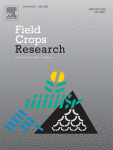View Item
- xmlui.general.dspace_homeCentros Regionales y EEAsCentro Regional Santa FeEEA ReconquistaArtículos científicosxmlui.ArtifactBrowser.ItemViewer.trail
- DSpace Home
- Centros Regionales y EEAs
- Centro Regional Santa Fe
- EEA Reconquista
- Artículos científicos
- View Item
Genetic progress in seed and fiber quality traits of cotton in Argentina
Abstract
Context: The Argentinian national cotton (Gossypium hirsutum L.) breeding program has demonstrated a 3.24 kg ha−1 y−1 genetic progress in lint yield from 1965 to date. Although previous studies have examined different trends in cotton lint yield, lint quality parameters, and other agronomic traits of cultivars over time, there have been no investigations in Argentina analyzing the genetic progress in the different components of technological fiber
[ver mas...]
Context: The Argentinian national cotton (Gossypium hirsutum L.) breeding program has demonstrated a 3.24 kg ha−1 y−1 genetic progress in lint yield from 1965 to date. Although previous studies have examined different trends in cotton lint yield, lint quality parameters, and other agronomic traits of cultivars over time, there have been no investigations in Argentina analyzing the genetic progress in the different components of technological fiber quality, cottonseed oil and protein composition.
Objectives: (i) to estimate the genetic progress of the lint and seed quality parameters among cultivars released in Argentina since 1965, (ii) to evaluate the variation of genetic progress for the lint and seed quality parameters under different environmental conditions, and (iii) to determine the correlations between lint quality and lint yield traits.
Method: This study was conducted over a two-year period, involving 20 cotton cultivars grown in four different environments (achieved through varying sowing dates) in Reconquista, Santa Fe, Argentina. Several fiber variables were evaluated, including upper half mean length (UHML), strength (Str), uniformity index (UI), micronaire (Mic), short fiber index (SFI), and spinning consistency index (SCI), as well as seed measurements, such as cottonseed oil content (Oil), protein content (Prot), and cottonseed oil fatty acid composition.
Results: Significant differences were observed in all the quality parameters evaluated according to the environment and genotype, highlighting the importance of agronomic management in improving the different quality parameters. Oil content in the genotypes and years studied showed significant increases over time. Likewise, the maintenance of quality parameters despite the significant increases in lint yield and some of its components is considered a positive result for the Argentinian breeding program. Pearson correlation analysis showed that LY was positively correlated with UHML, UI, SCI, oil, and linoleic acid, whereas LY was negatively correlated with SFI, and both stearic and oleic acids.
Conclusions: The data obtained from this study would serve as a basis for future research to explore the mechanisms responsible for altering or increasing both the fiber quality parameters and the concentrations of these by-products to improve cotton quality in Argentina.
[Cerrar]

Author
Fuente
Field Crops Research 302 : 109106. (October 2023)
Date
2023-10
Editorial
Elsevier
ISSN
0378-4290
1872-6852
1872-6852
Formato
pdf
Tipo de documento
artículo
Palabras Claves
Derechos de acceso
Restringido
 Excepto donde se diga explicitamente, este item se publica bajo la siguiente descripción: Creative Commons Attribution-NonCommercial-ShareAlike 2.5 Unported (CC BY-NC-SA 2.5)
Excepto donde se diga explicitamente, este item se publica bajo la siguiente descripción: Creative Commons Attribution-NonCommercial-ShareAlike 2.5 Unported (CC BY-NC-SA 2.5)


